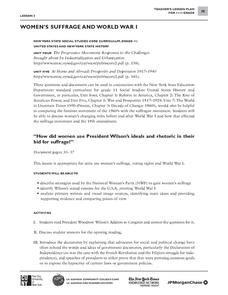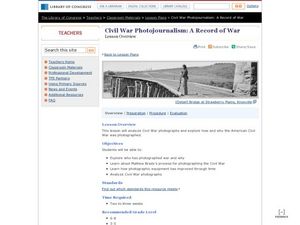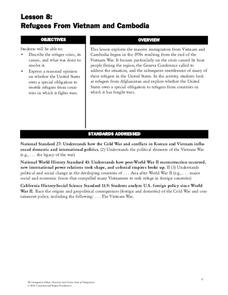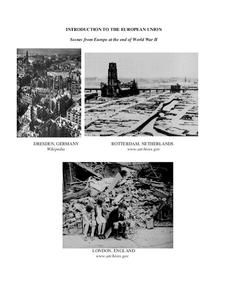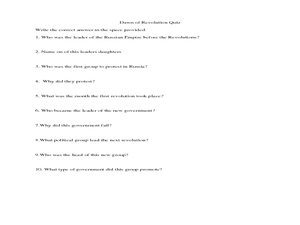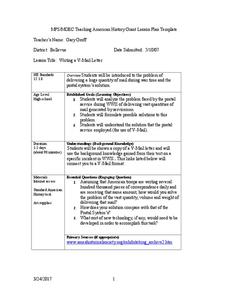City University of New York
Woman's Suffrage and World War I
How did women use President Wilson's ideals and rhetoric in their bid for suffrage? To answer this essential question, class groups analyze primary written documents and visual images.
Curated OER
1th Grade U.S. History from 1877
Eleventh graders engage in a lesson that is about the study of history in the United States after the end of World War I. They conduct research using a variety of resources and then summaries are written to explain the reasons for The...
Curated OER
H4 Homework Assignment #22-23
In this global studies worksheet, students read the noted pages in their textbooks and then respond to 8 short answer questions about Japanese involvement in World War II.
Curated OER
H4 Homework Assignment #35-39
In this global studies worksheet, learners read the noted pages in their textbooks and then respond to 5 essay and short answer questions about World War II and global regions.
Curated OER
Wilson's 14 Points
Young scholars analyze political cartoons representing the role of the U.S. in the Post-World War One Era. They work in groups and analyze cartoons for their stereotypes, symbols, and caricatures. After analyzing them, they complete a...
Curated OER
The Home Front: Convincing Americans to Help America Prepare
Sixth graders examine the actions of the U.S. Government after the attack on Pearl Harbor. In this preparation for war lesson, 6th graders analyze WWII posters and view a clip on the American Home Front. Students discuss and list the...
Curated OER
The United States and the Soviet Union were Engaged in a Cold War
Students work together at figuring out the definition for what cold war means. In this social science lesson, students listen to "The Butter Battle Book" by Dr. Seuss and recognize how this story relates to the cold war between the...
Curated OER
Civil War Photojournalism: A Record of War
Students view photographs of the Civil War. In this photojournalism lesson, students look at Mathew Brady's photographs of the Civil War. They discover the evolution of photographic equipment and analyze Civil War photographs.
Rutgers University
How the Allies Won World War II: Island-hopping in the Central Pacific
Using primary source documents, young historians explore the strategies the US used to defeat Japan during WWII. They also learn about the American military experience, and innovations that changed the style of warfare. Young scholars...
Stanford University
Soviets in Berlin
High school historians use their knowledge of WWII to analyze a photo of the Soviets entering Berlin. The social studies assessment is comprised of two short answer questions to assess academics' understanding of the historical...
Constitutional Rights Foundation
Refugees From Vietnam and Cambodia
The United States may have pulled its troops from the Vietnam War in 1973, but the conflict was far from over for the citizens living in Asia at the time. An informative resource lets learners know about the wave of over 220,000...
Curated OER
Introduction To The European Union
A lot happened to European economics, policy, and social systems after WWII. This 24 page social studies packet provides images, reading passages, comprehension questions, and critical thinking questions regarding all things Europe from...
Curated OER
WWI Document Based Essay
Learners read various primary source documents on World War I. After reading each document, they answer discussion questions. Using the internet, they identify the causes of World War I as layed out by President Wilson and his reasons...
Curated OER
The Internment of Ukrainians in Canada
Young scholars examine the condition of Ukrainian internment in Canada during World War I. In this World War I lesson, students research selected Internet sources to compare and contrast the internment of Ukrainians in Canada during...
Curated OER
The Enemy that Never Was
Students conduct research and explain in a speech why Japanese Canadians were not a threat to Canada during the Second World War.
Curated OER
Russian Revolution Part 1
Ninth graders consider how the outcome of World War I contributed the Russian Revolution. In this Russian Revolution lesson, 9th graders watch the movie "Anastasia," and discuss the conditions that led to revolution in Russia.
Curated OER
Fighting for Democracy, Fighting for Me
Students explore the contributions of African Americans, Japanese Americans, and Mexican Americans in World War II. In this World War II lesson, students research Internet and print sources regarding the treatment of the ethnic groups...
Curated OER
Social Effects of WWII on SC (Pt. 3)
Fifth graders examine the impact of World War II on South Carolina. In this American history instructional activity, 5th graders analyze primary documents that include political cartoons and advertisements that were published in South...
Curated OER
Holocaust Unit
Students read a book about World War II and the Holocaust while in small literature circles. They write journal entries and news articles based on the reading.
Curated OER
Nothing to Fear but Fear Itself
Students investigate the years during World War II in which Japanese Americans living on the West Coast were held in internment camps.
Curated OER
Writing a V-Mail Letter
Students investigate the challenges of delivering vast amounts of servicemen mail during World War II. In this historical perspectives lesson, students determine how to solve the problem that the postal service faced during the war and...
Curated OER
The Trenches
For this World War I study guide worksheet, learners investigate trench warfare. Students read sections of information and examine trench diagrams. Learners respond to 9 short answer question regarding the information presented.
Curated OER
The Cold War (1945–1963)
For this online interactive history worksheet, students respond to 8 short answer and essay questions about the Cold War. Students may check some of their answers on the interactive worksheet.
Stanford University
Korean War
Learners study the cause of the Korean War. In this World history lesson, Students read excerpts from two different textbooks, one from South Korea, and one from North Korea. They discuss how the cause of the war differs depending on the...


